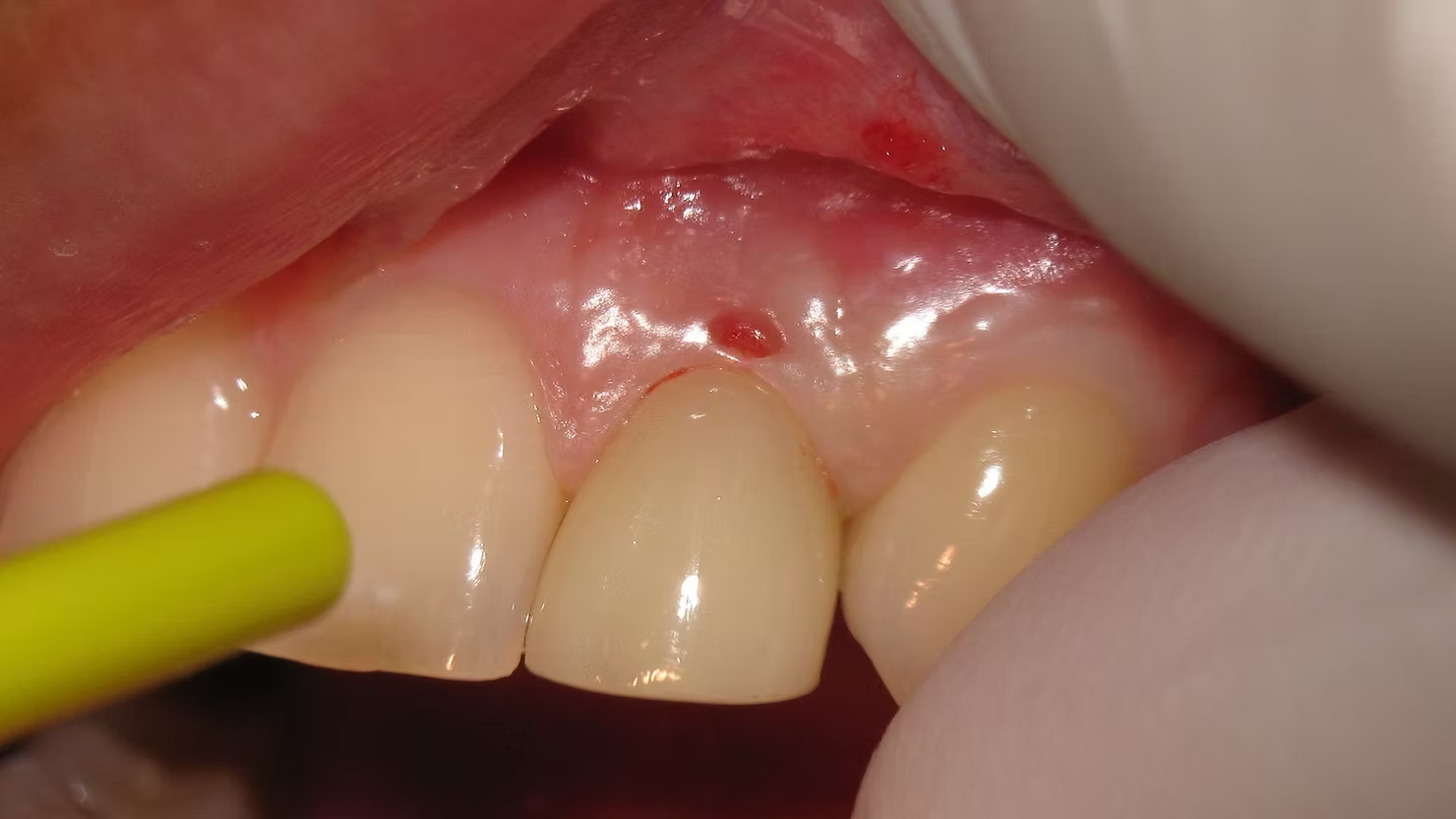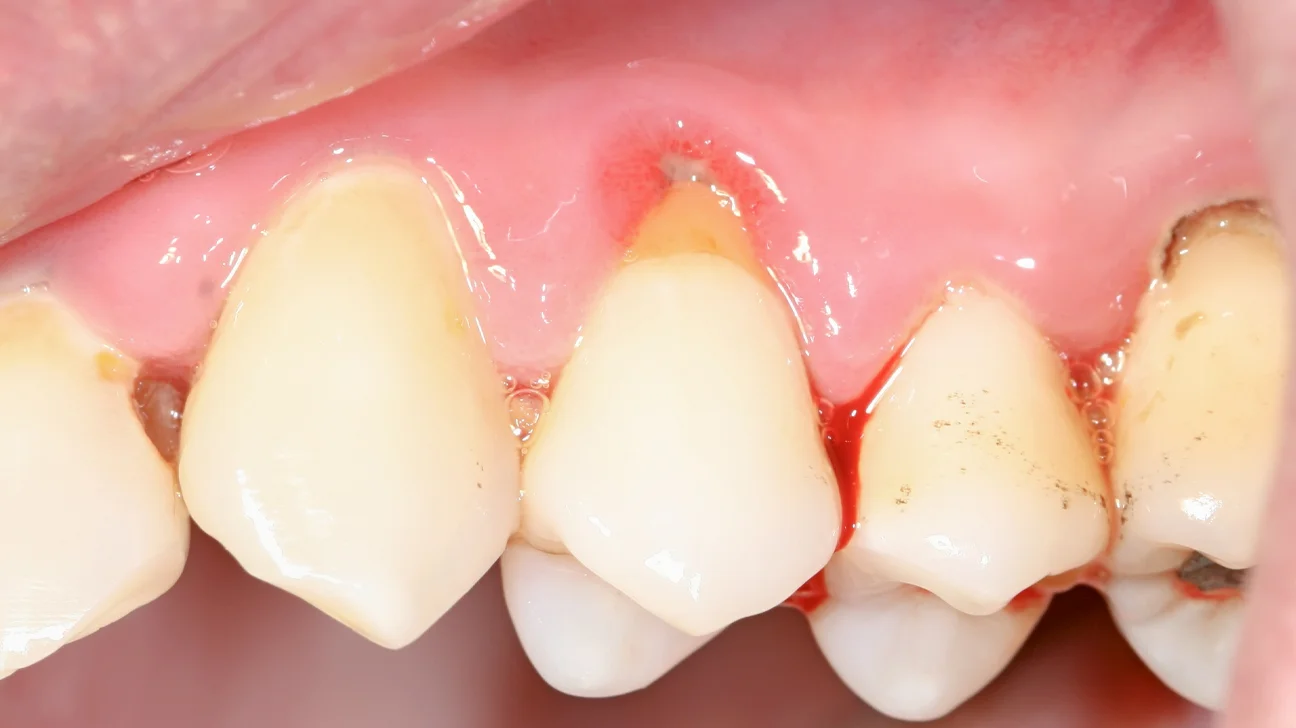Periodontitis affects almost half of Americans aged over 30. This serious condition can create holes in gums and cause severe tooth loss. Millions of professionals face this widespread oral health problem that could hurt their business success and career growth.
Holes in gums behind molars and other mouth areas signal more than dental problems. These issues become a serious health and professional concern. Untreated dental problems lead to tissue and bone loss. The visible holes in gum tissue damage both appearance and oral function. Business professionals must understand their gum problems and treat them quickly to avoid health complications and career setbacks.

Understanding Holes in Gums: The Hidden Business Cost
Holes in gums are more than just uncomfortable – they can seriously hurt your business prospects in ways many professionals don’t realize. These small dental problems can affect your finances and career growth by a lot.
What exactly is a hole in gum tissue?
A hole in gum tissue looks quite different from healthy gums around it. These spots sink in or crater instead of having the smooth surface you’d see in normal gums. The affected area often turns red, swells up, and bleeds when touched.
Periodontitis, a severe form of gum disease, causes most holes in gums. This condition destroys the tissue and bone that support your teeth. Your gums pull away from teeth and create pockets between them. These holes can show up anywhere along your gumline but you’ll often find them where teeth meet gums and behind molars.
These aren’t just regular tissue problems – a hole behind your molar or elsewhere points to serious issues underneath. Bacteria can use these openings to get deeper into your gums and possibly damage your bone structure and teeth. Small holes might not seem like much now, but they usually get worse without treatment.
The financial impact of untreated gum holes
Untreated gum holes cost way beyond your dental bills. The numbers are staggering for people, businesses, and healthcare systems:
- US spends about $154 billion yearly on untreated gum disease
- Oral diseases worldwide cost around $710 billion in treatment and lost work time each year
- American companies lose $45 billion yearly because workers miss work or can’t focus due to oral pain
- Employers lose $54 billion in productivity from poor oral health
Dr. David Okano, who leads the American Academy of Periodontology, puts it this way: “Taking the proper steps to prevent gum disease may seem like a burden, but an ounce of prevention is worth a pound of care. Once the disease takes hold, the costs to treat it are much higher”.
These numbers don’t even count other costs like doing worse at work, missing out on promotions, or paying more for related health problems.
How gum problems affect your professional image
Bad gum conditions can really hurt your professional credibility. ADA research shows that 38% of people say poor oral health makes life less enjoyable. About one in five working adults say their teeth’s appearance affects how they do in job interviews. This number goes up to 29% for people with lower incomes.
Career-focused professionals should worry because hiring managers show clear bias. Studies prove that people with visible dental problems, including gum holes, seem less smart, less appealing, and less trustworthy than those with healthy smiles. This means qualified candidates might lose opportunities just because of their oral health.
The effects reach beyond just getting hired. About a quarter of adults never smile because they’re worried about their teeth, and 22% of young professionals skip social events for the same reason. This behavior limits their chances to network and build relationships – key elements for moving up in their careers.
Fixing holes in your gums isn’t just about dental health – it’s a smart career move that can open doors to better professional opportunities.
Common Causes of Hole in Gums Behind Molar and Other Areas
The mechanisms behind holes in gums play a vital role for professionals who want to safeguard their health and career path. These oral health problems stem from several distinct conditions that bring their own business challenges and treatment needs.
Periodontitis: The silent productivity killer
Periodontitis, an advanced form of gum disease, affects 47.2% of adults over age 30 in the United States. This systemic condition starts with plaque buildup that moves from gingivitis (mild gum inflammation) to a serious condition that destroys supporting tissue and bone.
The gums pull away from teeth as periodontitis progresses. This creates distinctive pockets or holes between teeth and gums. Bacteria can then penetrate deeper when tissue separates, which damages bone and connective tissues further.
The financial toll is massive. The direct costs to treat periodontal disease hit $3.49 billion in the US during 2018. Business professionals face an even bigger challenge with indirect costs. Productivity losses from periodontal disease reached $150.57 billion in the US.
Money isn’t the only concern. Periodontitis shows through several symptoms that disrupt workplace performance:
- Red, swollen gums that bleed easily
- Bad breath that won’t go away (a problem for client-facing roles)
- Gums that pull back to expose sensitive tooth roots
- Pain when eating (which affects business meals)
- Teeth that loosen and might need removal
Infections that create small holes in gums
Holes in gum tissue often come from viral and bacterial infections. These infections leave distinct lesions that look concave or cratered and might form painful ulcers.
Herpetic gingivostomatitis serves as a prime example. The herpes simplex virus (HSV) causes this condition that creates lesions throughout the mouth, including the gums. Business professionals should watch for its clear signs: red, swollen gums plus fever, poor appetite, feeling unwell, and swollen lymph nodes.
Pericoronitis happens when wisdom teeth don’t fully emerge. This creates a gum tissue flap (operculum) where bacteria get trapped. Serious cases can spread infection beyond the jaw into cheeks and neck. Executives who speak often face a real challenge when symptoms like trismus (trouble opening the mouth) make communication difficult.
Post-extraction complications
Professionals need recovery time after tooth extraction. The extraction site leaves a “hole” in gum tissue that bone usually fills over about 8 weeks. In spite of that, complications can extend recovery and hurt productivity.
Dry socket tops the list of post-extraction problems. It happens when the protective blood clot comes out too soon. Raw nerve endings and bone become exposed, which causes intense pain that can reach the ear, eye, temple, or neck. Professionals with packed schedules often miss extra work days to treat this issue.
Osteomyelitis ranks among the rare but serious complications. This bone infection might develop in contaminated extraction wounds. Though uncommon, it can stop you in your tracks with fever, swelling, tenderness, and fatigue—symptoms that destroy productivity for busy professionals.
These causes, once understood, give professionals the ability to get quick treatment. This approach can save thousands in advanced treatment costs and prevent major career disruptions.
Identifying the Problem: Why Is There a Hole in My Gums?
Early detection of holes in gums can save professionals thousands in treatment costs and prevent career disruption. Busy executives often miss critical warning signs until the condition gets worse. The core team can help at stages when treatment costs less and works better.
Visual indicators of gum disease
Healthy gums look firm and pink, fit snugly around teeth, and don’t bleed during normal brushing or flossing. The core team should watch for these visual signs of gum problems:
- Reddish or purplish coloration instead of healthy pink tissue
- Swollen, puffy appearance compared to the firm texture of healthy gums
- Gum recession making teeth appear longer than before
- Cratered or indented areas where gum tissue appears different from surrounding areas
- Visible pus when pressing on gum tissue
Affected areas’ texture and appearance differ from surrounding healthy tissue. A hole in gums behind molars or elsewhere looks cratered or indented compared to healthy tissue’s smoothness.
When to be concerned about a hole on gums
Small abnormalities might seem minor, but certain warning signs just need professional attention:
Pocket depth measurements serve as the most reliable indicator of gum disease severity:
- 1-3 mm: Generally healthy gums
- 4 mm: Borderline issues that just need improved oral care
- 5-6 mm: 6-month old gum disease that just needs dental consultation
- 7+ mm: Advanced disease that just needs specialist treatment
A hole in gum tissue with persistent bad breath, loose teeth, or pain while eating shows advanced disease that just needs intervention. Fever, swollen lymph nodes, or spontaneous bleeding with gum holes points to serious infection.
Self-examination techniques for busy professionals
Executives can use these quick self-assessment methods:
- Mirror examination: Good lighting and a clear mirror help check your gums for changes in color, texture, or recession. Look for small holes in gums behind molars where problems start.
- The bleed test: Bleeding gums often show early disease. Notice any blood after brushing or flossing.
- Tongue detection: Your tongue can feel irregularities, indentations, or holes on gums that weren’t there before.
- Self-questionnaire: Ask yourself these key questions: Do your gums bleed during brushing? Can you wiggle any teeth with your tongue? Does your gum line look uneven when you smile? “Yes” answers mean you should see a professional.
These quick checks take minutes but warn you about developing issues. Finding small holes in gums early helps professionals avoid both financial costs and career interruptions from advanced treatments.

Treatment Options: The ROI Perspective
Treating holes in gums needs a smart investment approach that balances costs against health benefits. You need to understand the economics of treatment options to make smart decisions about your dental health investment.
Cost-benefit analysis of early intervention
Early action makes the most financial sense when treating holes in gums. Studies show that non-surgical procedures give better economic returns than surgical ones. A model-based analysis shows that proper periodontal treatment saves USD 5,904 over a lifetime if you have type 2 diabetes. This treatment also improves quality of life by 0.6 years.
The costs vary based on how severe the condition is:
- Early-stage treatment with scaling and root planing costs USD 100 to USD 300 per quadrant
- Gum graft surgery costs USD 600 to USD 1,200 per tooth in advanced cases
- Flap surgery might set you back USD 1,000 to USD 3,000 per quadrant in severe cases
Local delivery devices don’t give any economic advantage despite their higher costs. Standard non-surgical approaches work better in most cases of hole in gums behind molar or other locations.
Insurance coverage considerations
Dental insurance helps cover the cost of periodontal disease treatments. A complete dental policy costs about USD 52 monthly (USD 624 annually) and covers much of the treatment costs for small holes in gums.
Your insurance coverage depends on:
- How severe your condition is (advanced cases get higher coverage)
- Medical necessity versus cosmetic concerns
- Impact on overall health
The Pinhole Surgical Technique (PST) gets insurance coverage in most states. This technique offers a minimally invasive way to treat gum recession linked to hole in gum issues.
Time investment for different treatment approaches
Different treatments need different healing times:
- Scaling and root planing needs 1-2 weeks to heal
- Flap surgery takes 4-6 weeks to recover
- Bone grafting requires several months for full recovery
PST stands out because it has “virtually no post-operative recovery time”. You can return to your normal activities right away with minimal care. This quick recovery is great news if you can’t take much time off work.
Regular maintenance sessions (USD 100-200 each) are vital to keep up the results, whatever treatment you choose for your hole in gums behind molar or other gum issues.
Prevention Strategies for the Time-Conscious Professional
Busy executives need smart time management, not just extra time for oral care to prevent gum problems. The quickest way to protect your professional image and save thousands in treatment costs is to implement preventive strategies.
Efficient daily oral care routines
Quality matters more than quantity for healthy gums. Here’s how to make your oral care more effective:
- Two-minute brushing sessions twice daily with fluoride toothpaste and a soft-bristled brush at a 45-degree angle toward your gums helps remove plaque at the gum line
- Electric toothbrushes clean better than manual ones because their vibrations deliver more strokes
- Daily flossing targets spaces between teeth where gum problems often start behind molars
Bacteria in your mouth doubles every four to five hours. Brushing after meals helps stop bacterial buildup that creates gum problems.
Strategic scheduling of dental appointments
Smart professionals plan their dental visits carefully:
- Book appointments early morning or late evening to avoid disrupting your workday
- Reserve your slots weeks or months ahead, before your calendar fills up
- Look for dental practices with weekend hours or same-day visits for more flexibility
- Choose practices offering multiple treatments in one location to avoid referrals
A 5% no-show rate at dental offices wastes 16 days of clinical time yearly. Regular preventive visits save you time compared to emergency treatments for gum issues.
Dietary choices that protect gum health
Your food choices can protect your gums without taking extra time:
- Vitamin C-rich foods (citrus fruits, berries) reduce gum inflammation
- Dairy products boost saliva production that naturally cleans teeth
- Crunchy vegetables like carrots and celery work as natural toothbrushes
- Fish rich in omega-3 fatty acids help control gum tissue inflammation
Sugar and refined carbohydrates encourage plaque formation that damages gums behind molars. Limiting these foods is a simple prevention strategy that fits into your schedule naturally.
Taking care of holes in gums isn’t just about health – it’s a smart business move too. Your career success often depends on tiny details, and healthy gums become a valuable asset rather than a basic dental issue.
Smart executives know that prevention gets nowhere near as expensive as treatment. Advanced gum problems can cost thousands per quadrant to fix, while basic oral health needs minimal investment. Regular dental care makes perfect business sense, especially when you look at the $154 billion yearly cost of untreated gum disease across the country.
Business leaders need to see gum health as an investment opportunity. Finding and treating small gum holes early brings better returns than waiting for major procedures. It also helps protect your money and professional image when you stop holes from forming behind your molars through planned oral care.
Successful professionals can’t ignore their oral health anymore. Quick action against developing gum problems protects your career path, helps avoid pricey treatments, and keeps the confidence you need to succeed in business. People who make gum health a priority today set themselves up for better health and stronger professional opportunities down the road.
Here are some FAQs about hole in gums:
Is a hole in gum serious?
A hole in gums can be serious depending on its cause and size. If you notice a hole in gums behind molar or anywhere else, it could indicate gum disease, infection, or tooth abscess. Looking at gingivitis pictures of hole in gums can help you compare your symptoms, but you should always consult a dentist for proper diagnosis.
How do you get rid of a hole in your gum?
To treat a hole in gums, your dentist may recommend deep cleaning, antibiotics, or surgical procedures depending on the cause. For minor cases, improved oral hygiene with proper brushing and flossing can help heal why is there a hole in my gums situations. Severe cases showing in pictures of hole in gums often require professional intervention to prevent further damage.
What causes a hole in the teeth gum?
A hole in gums behind molar or other areas can be caused by advanced gum disease, tooth abscess, or trauma to the gum tissue. Looking at gingivitis pictures of hole in gums reveals how periodontal disease can create these openings. Other causes include poorly fitting dental appliances or aggressive tooth brushing that damages gum tissue.
Can an open gum heal on its own?
Small holes in gums may heal on their own with proper oral care, but larger openings typically need professional treatment. If you’re wondering why is there a hole in my gums that isn’t healing, it likely requires dental attention. Pictures of hole in gums that have healed show healthy pink tissue filling the space completely.
Do gum holes heal?
Yes, gum holes can heal with proper treatment and oral hygiene, especially when caught early. The healing process depends on what caused the hole in gums behind molar or other areas. Looking at gingivitis pictures of hole in gums before and after treatment shows how effective care can restore healthy gum tissue.
Do gum pockets heal on their own?
Gum pockets, a common sign of periodontal disease, typically don’t heal on their own without treatment. While you might notice some improvement in why is there a hole in my gums situations with better hygiene, professional cleaning is usually needed. Advanced cases shown in pictures of hole in gums often require more extensive periodontal therapy.
What does gum decay look like?
Gum decay often appears as red, swollen tissue with possible holes in gums or receding gum lines. Comparing your symptoms to gingivitis pictures of hole in gums can help identify issues. You might notice pus, bleeding, or dark spots where the gum tissue is deteriorating around teeth.
Can I poke a hole in a gum abscess?
You should never poke a hole in a gum abscess yourself as this can spread infection. If you notice a hole in gums behind molar that seems to be an abscess, see a dentist immediately for proper drainage and treatment. Pictures of hole in gums caused by burst abscesses show why professional care is essential for proper healing.
What does a healing gum hole look like?
A healing hole in gums will show gradual filling in of the space with healthy pink tissue. Comparing to gingivitis pictures of hole in gums during healing, you’ll notice reduced redness and swelling around the area. Complete healing of why is there a hole in my gums situations results in smooth gum tissue with no visible depression.
FOLLOW US ON FACEBOOK
RECENT POSTS
TAGS
About The Memory Hole
You've reached TheMemoryHole.org! A diverse lifestyle blog with content on a variety of different topics to help you define and live the life you want to live! Thanks for stopping by!
Copyright © The Memory Hole. All rights reserved.







